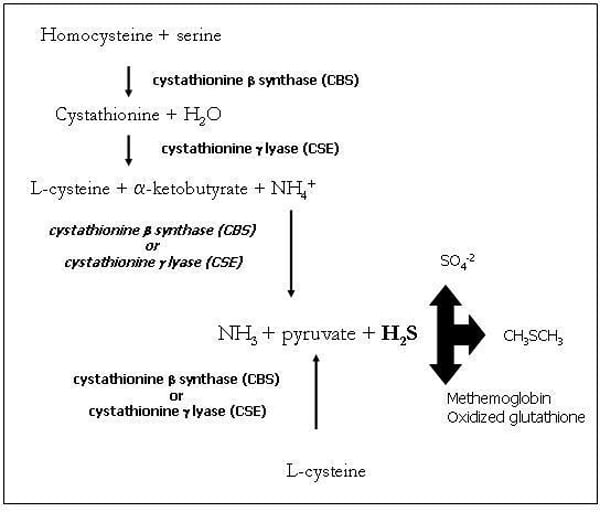Historically hydrogen sulphide is best known as a toxic gas that has a typical smell of rotten eggs. Hydrogen sulphide can be generated endogenously from L-cysteine in a reaction catalysed by cystathionine gamma lyase (CSE) or cystathionine beta synthase (CBS) It is now known that hydrogen sulphide can directly alter smooth muscle tone .The expression of CBS and CSE appears to be tissue specific. CSE has been described to be widely expressed in peripheral vascular tissues and the heart. The actions of H2S itself have been studied in vascular tissues and uterine strips from pregnant rats , in which the predominant effect was relaxation. Similarly, it has been recently demonstrated that NaHS induces a dose-dependent relaxation of the rabbit ileum and rat vas deferens . In rat studies, bolus injection of hydrogen sulphide produced a transient decrease in mean arterial blood pressure. The possible role payed as mediator by hydrogen sulphide in vivo is further supported by the finding that the plasma levels of hydrogen sulphide in spontaneous hypertensive rats is significantly lower than that of the matching background e.g. WKY. The mechanism through which hydrogen sulphide exerts its relaxant properties is not fully understood, although it is likely mediated by the opening of K+ ATP channels. Hydrogen sulphide exerts a relaxant effect on rat aortic tissue and induces a transient reduction of blood pressure through a direct stimulation of K+ ATP channels and subsequent hyperpolarization of rat aortic vascular smooth muscle cells. Indeed, glibenclamide, a K+ ATP channel antagonist, reversed these actions, while pinacidil, a K+ ATP channel opener, mimicked the hydrogen sulphide -induced relaxation. These results have been recently confirmed using a sophisticated whole-cell and single-cell patch-clamp technique. Other potential targets of action of hydrogen sulphide on vascular smooth muscle include voltage-dependent Ca2+ channels and Ca2+-dependent K+ channels. Hydrogen sulphide has also effects on the heart where exogenous administration of NaHS (as a source of hydrogen sulphide ) caused negative inotropism without affecting heart rate and coronary perfusion flow Interestingly hyperhomocysteinemia is a disease characterized by deficient expression of CBS which causes peripheral and cerebral occlusive arterial disease and the role of hydrogen sulphide in this pathology has never been addressed in depth yet it may be cause of atherosclerosis and/or thrombotic complications associated to hyperhomocysteinemia. In addition following heart transplantation the vascular diseases that develops are coupled to an increase in plasma homocysteine concentration. In addition recently there has been a growing body of evidence suggesting a cross-talk between NO and hydrogen sulphide suggesting that the balance between these two gaseous mediators may play an important role in the vascular homeostasis.While the major reported effect of hydrogen sulphide in the context of smooth muscle is relaxation, it is noteworthy that in some tissues and in some species, hydrogen sulphide can exert powerful contractile responses. In conclusion the current literature indicates hydrogen sulphide as a biologically active molecule that has mainly a vasodilator effect in vivo and in vitro and this is opening a new avenue in the search for new therapeutic targets in the cardiovascular field.
Life Sciences 2007 (2007) Proc Life Sciences, SA210
Research Symposium: Emerging roles for blood vessel wall hydrogen sulphide in vascular function
G. Cirino1
1. Experimental Pharmacology, Università di Napoli Federico II, Napoli, Italy.
View other abstracts by:
Where applicable, experiments conform with Society ethical requirements.

